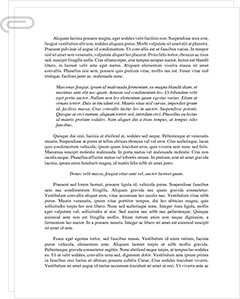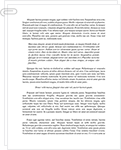 Study Document
Study Document
Crime Of Arson Essay
Pages:6 (1518 words)
Document Type:Essay
Document:#878803
Essay Topic Examples
1. The Psychological Profile of Arsonists:
Explore the psychological motivations behind arson, including case studies and expert analysis on what drives individuals to commit this crime.
2. Arson in Urban vs. Rural Settings:
Compare and contrast the frequency, motives, and impact of arson in urban environments versus rural areas, highlighting differences in detection, response, and prevention strategies.
3. Legal Framework and Arson:
Discuss the legal definitions, penalties, and challenges in prosecuting arson cases, including how laws vary by jurisdiction and the effectiveness of current legal measures.
4. The Role of Fire Investigation in Arson Cases:
Examine how fire investigation techniques have evolved to identify arson, the challenges investigators face, and the importance of forensic science in solving these crimes.
5. Arson as a Tool for Insurance Fraud:
Analyze cases where arson has been used to commit insurance fraud, exploring the methods used, the detection by insurance companies, and the legal repercussions.
Essay Title Examples
1. "Burning Ambitions: The Psychology of Arson"
2. "Fire and Law: The Legal Battle Against Arson"
3. "From Match to Motive: Understanding Arson"
4. "The Heat of Crime: Arson in Modern Society"
5. "Arson's Aftermath: Community Impact and Recovery"
Essay Hook Examples
1. "In the dead of night, a flicker of light turns into a blaze that consumes not just property but lives, dreams, and futures."
2. "Imagine waking up to the smell of smoke, only to find your life's work reduced to ashes by an unknown hand."
3. "Arson, often seen as a crime of passion or revenge, hides deeper psychological scars and societal issues."
4. "Every year, fires of unknown origin claim countless structures, but behind each flame might lurk the deliberate act of arson."
5. "The crackle of fire can be mesmerizing, but when it's set by human hands with malicious intent, it becomes a tool of destruction."
Thesis Statement Examples
1. "Arson, while often perceived as a spontaneous act of destruction, is deeply rooted in psychological disorders and societal pressures, necessitating a multifaceted approach to prevention and rehabilitation."
2. "The legal system's approach to arson needs reevaluation to address the complexities of proving intent and motive, which are crucial for effective prosecution and deterrence."
3. "Advancements in fire investigation technology are pivotal in distinguishing arson from accidental fires, thereby enhancing the accuracy of legal outcomes and community safety."
4. "Arson as a method of insurance fraud not only undermines economic stability but also erodes trust in insurance systems, calling for stringent regulatory measures."
5. "The impact of arson extends beyond physical damage, affecting community cohesion and psychological well-being, highlighting the need for comprehensive recovery programs."
Essay Outline Examples
I. Introduction
Background on Arson
Definition and legal classification of arson
Historical context and evolution of arson laws
Thesis Statement
Statement on the psychological underpinnings of arson
Importance of understanding these motivations for prevention
II. Body
Psychological Motivations
Case studies of known arsonists
Common psychological profiles and triggers
Impact on Society
Economic and social costs of arson
Community response and recovery efforts
Legal and Investigative Challenges
Difficulties in proving intent
Role of forensic science in arson investigation
III. Conclusion
Summary of Key Points
Recap of psychological insights and societal impacts
Importance of legal and investigative advancements
Call to Action
Encouragement for community involvement in prevention
Advocacy for better mental health support systems
Essay Introduction Examples
Introduction Paragraph 1
Arson, the act of deliberately setting fire to property, is not merely a crime of destruction but a complex interplay of psychological, social, and legal elements. Historically, arson has been used as a tool for revenge, insurance fraud, or to cover up other crimes, but its implications stretch far beyond the immediate physical damage. The psychological motivations behind arson are as varied as the individuals who commit it, ranging from thrill-seeking to deep-seated psychological disorders. This essay delves into the multifaceted nature of arson, exploring how understanding the psychological profiles of arsonists can lead to better prevention strategies. By examining case studies, we can uncover patterns in behavior that might predict or prevent future incidents, thereby safeguarding communities and reducing the economic and emotional toll of this destructive act.
Introduction Paragraph 2
Arson, often perceived as a spontaneous act of rage or mischief,…
…the act of setting fires provides a sense of relief or pleasure. Understanding these psychological underpinnings is vital for prevention. Programs aimed at early intervention, like those focusing on at-risk youth or individuals with known mental health issues, can significantly reduce the incidence of arson by addressing the root causes before they manifest into criminal behavior.
Essay Conclusion Examples
Conclusion 1
In conclusion, arson is a crime that demands a comprehensive approach involving psychological understanding, legal rigor, and community resilience. By delving into the minds of arsonists, we can better predict and prevent these acts. The legal system must continue to evolve to meet the challenges of proving intent and motive, ensuring that justice is not only served but also seen to be served. Communities play a pivotal role in recovery, not just in rebuilding physical structures but in restoring trust and safety. It is through a collective effort, combining psychological insights, legal advancements, and community action, that we can hope to mitigate the devastating effects of arson.
Conclusion 2
Arson, with its deep psychological roots and significant societal impact, requires a multifaceted response. This essay has highlighted the importance of understanding the motivations behind arson, the legal complexities in its prosecution, and the community's role in both prevention and recovery. Moving forward, there must be an increased focus on mental health support, legal reforms, and community education to address and prevent arson effectively. Only through such integrated efforts can we hope to reduce the frequency and severity of arson, protecting lives, property, and the social fabric from the flames of malice.
In-Text Citation Examples
In-Text Citation Examples
In-text citation examples:
1. The complexity of arson investigations often requires a detailed understanding of fire behavior, as outlined in the "Fire Investigation Handbook" (Smith 45).
2. Legal challenges in arson cases are frequently discussed in "Legal Aspects of Arson," where the importance of evidence preservation is emphasized (Johnson 122).
3. in-text citation 3 integrated in a sentence.
4. in-text citation 4 integrated in a sentence.
Sources Used:
1. Fire Investigation Handbook
2. Legal Aspects of Arson
Primary Sources
Fire Investigation Handbook
Arson: A Handbook of Detection and Investigation
NFPA 921: Guide for Fire and Explosion Investigations
Legal Aspects of Arson
Psychology of Arsonists
Related Documents
 Study Document
Study Document
Arson Is a Fire Purposely
Such determination is the goal of any arson investigation. The advantages of accurate and thorough fire investigations should be obvious. All fifty states statutorily allow public investigations of all fires in an effort to determine their origins and causes. This process, however, is not without complications and, too often, the cause and origin are left as unresolved and identified as undetermined causes. Some fires are the result of complex events whose
 Study Document
Study Document
Crime Of Arson
1.The Psychological Profile of Arsonists: Unpacking the Motivations Behind Fire-Setting: This essay would explore the different psychological factors that can lead an individual to commit arson. It would examine various motivations such as desire for attention, revenge, financial gain, or satisfaction of pyromaniac impulses, and how they correlate with the profiles of convicted arsonists. 2.Arson as a Weapon of Environmental Terrorism: The focus of this essay would be on
 Study Document
Study Document
Crimes Against Property
Crimes Criminal Activities Crimes against public disorder In order to be convicted of disorderly conduct, according to the State of Massachusetts the defendant must have committed three specific things: 1) involved themselves in fighting, threatening, or violent behavior, or create a situation that is hazardous or physically offensive, 2) the defendants actions were most likely to affect the public, and 3) the defendant must have intended to cause public inconvenience, annoyance or alarm,
 Study Document
Study Document
Crime Rates and Abandoned Buildings the Research
Crime Rates and Abandoned Buildings The research question will help to focus the study and determine the long-term effects of crime rates and abandoned buildings. It includes: Is there a direct relationship between crime rates and abandoned properties inside a community? This allows actuaries to concentrate on how these trends are developing and the long-term effects on different regions. The hypothesis will show that there is a direct correlation between various crime rates and
 Study Document
Study Document
Crime Reporting What Do You Think Crime
Crime Reporting What Do You Think? Crime Reporting: UCR and NCVS The Uniform Crime Report is a compilation of offensives collected by the Federal Bureau of Investigation (FBI) from all police stations in the United States. Data collected is divided into two groups, Part I and Part II. Part I data includes violent and property crimes such as aggravated assault, forcible rape, murder, robbery, arson, burglary, larceny-theft, and motor vehicle theft. Part II
 Study Document
Study Document
Arson Over Thirty Thousand Structural
(Prins, Fire-Raising) The increase in juvenile crime related arson is particularly troubling. One theory suggest that undiagnosed and untreated conduct disorder in early childhood may be the progenitors in the creation of an arsonist: From a diagnostic perspective, firesetting is a strong predictor of the continuation of conduct disorder and, in field trials, was found to be the fourth most discriminating behavior for this diagnosis among 14 diagnostic criteria, according to




